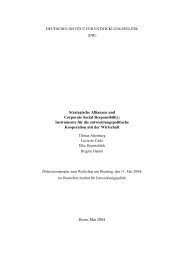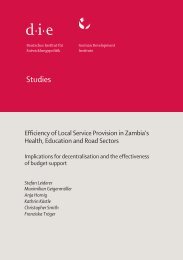Middle East / North Africa and the Millennium Development Goals ...
Middle East / North Africa and the Millennium Development Goals ...
Middle East / North Africa and the Millennium Development Goals ...
You also want an ePaper? Increase the reach of your titles
YUMPU automatically turns print PDFs into web optimized ePapers that Google loves.
<strong>Middle</strong> <strong>East</strong> / <strong>North</strong> <strong>Africa</strong> <strong>and</strong> <strong>the</strong> <strong>Millennium</strong> <strong>Development</strong> <strong>Goals</strong><br />
contracted malaria in 2001: 27 per 100,000 population in Oman <strong>and</strong> 32 per<br />
100,000 in Saudi Arabia. The reason for this is <strong>the</strong> relatively high number<br />
of migrant workers in <strong>the</strong> Gulf states. These people may already have <strong>the</strong><br />
disease when <strong>the</strong>y arrive or <strong>the</strong>y may return infected when <strong>the</strong>y travel<br />
home on vacation leave (ESCWA 2005).<br />
Some countries in <strong>the</strong> region are also affected by leishmaniasis (Aleppo<br />
boil, kala-azar), a disease which is also transmitted by mosquitoes. These<br />
countries mainly include Morocco, Algeria, Tunisia, Iraq, <strong>and</strong> Sudan, although<br />
<strong>the</strong> disease also broke out again in Syria a number of years ago,<br />
where attempts to get it under control have not yet proven successful. In<br />
2001 <strong>the</strong> number of new cases countrywide was 135 per 100,000 population<br />
(Syrian Arab Republic 2003).<br />
By international comparison, tuberculosis constitutes a minor health risk in<br />
<strong>the</strong> MENA region. Only three countries are seriously affected by <strong>the</strong> disease:<br />
Mauritania (per year 209 new infections <strong>and</strong> 51 deaths per 100,000<br />
inhabitants), Sudan (142 new cases <strong>and</strong> 51 deaths per 100,000), <strong>and</strong> Iraq<br />
(89 new cases <strong>and</strong> 27 deaths per 100,000). No information is available on<br />
how <strong>the</strong> disease has developed in <strong>the</strong>se three countries in recent years (see<br />
Table A8, Annex).<br />
The incidence of tuberculosis is in decline in most countries of <strong>the</strong> region.<br />
This can be shown clearly for Jordan, Lebanon, <strong>and</strong> Morocco, although<br />
<strong>the</strong>re is also information available that indicates <strong>the</strong> same trend for Egypt,<br />
Bahrain, Saudi Arabia, <strong>and</strong> Tunisia (PARC 2002; Kingdom of Bahrain /<br />
UN 2002; Jordan MOPIC 2004; UN 2003a; UN 2002b; UN 2003b).<br />
Hepatitis B <strong>and</strong> C continue to be endemic in all countries of <strong>the</strong> region. In<br />
recent years Syria <strong>and</strong> Egypt appear to have been faced with particular<br />
problems with <strong>the</strong>se diseases (Syrian Arab Republic 2003; PARC 2002).<br />
Finally, <strong>the</strong> Palestinian Territories experienced an epidemic of viral meningitis<br />
in 1997. The infection rate was 117 per 100,000 population, a figure<br />
that was reduced to 22 per 100,000 population by 2002. However, bacterial<br />
meningitis continues to spread (UN 2002a).<br />
German <strong>Development</strong> Institute 79

















